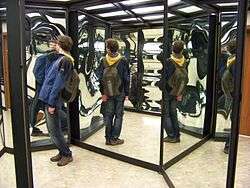House of mirrors

A house of mirrors or hall of mirrors is a traditional attraction at funfairs (carnivals) and amusement parks. The basic concept behind a house of mirrors is to be a maze-like puzzle.[1] In addition to the maze, participants are also given mirrors as obstacles, and glass panes to parts of the maze they cannot yet get to. Sometimes the mirrors may be distorted because of different curves, convex, or concave in the glass to give the participants unusual and confusing reflections of themselves, some humorous and others frightening.
References in fiction
Literary
The first known literary example is in Gaston Leroux's novel The Phantom of the Opera (1911), in which Erik has built one for the Shah of Persia as a trap and later uses a similar trap to protect his lair from his enemies. Perhaps the first cinematic instance of this was at the climax of the film The Lady from Shanghai (1948). Other notable examples include Woody Allen's movie Manhattan Murder Mystery (1993) which directly refers to The Lady from Shanghai; the CBS soap Guiding Light which, in 1980, featured a now famous sequence that depicted heroine Rita Bauer (Lenore Kasdorf) being pursued through a hall of mirrors by villain Roger Thorpe (Michael Zaslow); the show Macgyver, where Jack Dalton is brainwashed and is forced to fire on Macgyver; and the Teen Titans series episode "Betrayal". Francisco Scaramanga's "Fun House" in the James Bond film The Man with the Golden Gun has a House of mirrors. In an episode of the Twilight Zone, "In Praise of Pip", a bookie tries to tell his dying son how much he loves him while chasing him inside a house of mirrors; the 1984 movie Conan the Destroyer with Arnold Schwarzenegger contains a house of mirrors fight, and the 1983 Walt Disney movie Something Wicked This Way Comes (an adaptation of Ray Bradbury's novel of the same title) culminates in a house of mirrors confrontation. In the fourth season of the show Leverage, in the episode "The Carnival Job", Elliot has a showdown with Molly's captors in a house of mirrors.
The concept has also been used in comics. In Batman: The Dark Knight Returns, Batman is seen chasing the Joker through an amusement park and into a hall of mirrors. It was used to create suspense as Joker could not clearly decipher what was real and what was just an image.
Film
In John Boorman's 1974 movie Zardoz character "Z" (Sean Connery) battles against "The Vortex" in a mirror maze.
One of the most famous ending sequences in film history related to a House of Mirrors is in Enter the Dragon, starring Bruce Lee. The finale takes place in a house of mirrors, where Bruce Lee learns it is best to smash the glass obstacles to solve his problem and defeat the villain.
John Wick: Chapter 2 (2017) - John Wick (Keanu Reeves) engages in a chase, gunfight, and climactic knife fight in a multi-floor modern art museum exhibit called "Reflections of the Soul" made of halls, rooms, and stairways lined with mirrors with lights and video screens reflected in them.
Music
The Kraftwerk album Trans-Europe Express includes a song called "The Hall of Mirrors". Fusion guitarist Allan Holdsworth also has a song called "House of Mirrors" of his Hard Hat Area album. The Insane Clown Posse album The Ringmaster has a song called "House of Mirrors", representing it as one of the attractions of the Dark Carnival.
History
The origins of the house of mirrors stems from the hall of mirrors in the Palace of Versailles.
Upon a visit to France to discuss colonial land agreements, Peter Stuyvesant arrived at the Palace of Versailles and gazed upon the hall of mirrors present in the palace. Peter (or Petris) became determined to bring this amazement to the newly founded colonial city of New Amsterdam, of which he was governor. Peter Stuyvesant's House of Mirrors was founded in 1651 and he charged one Dutch gulden for admission.
See also
References
- ↑ Styer, Joel. "Funhouse at Jenkinson's Beach Boardwalk". Darkride and Funhouse Enthusiasts. Retrieved 17 December 2012.